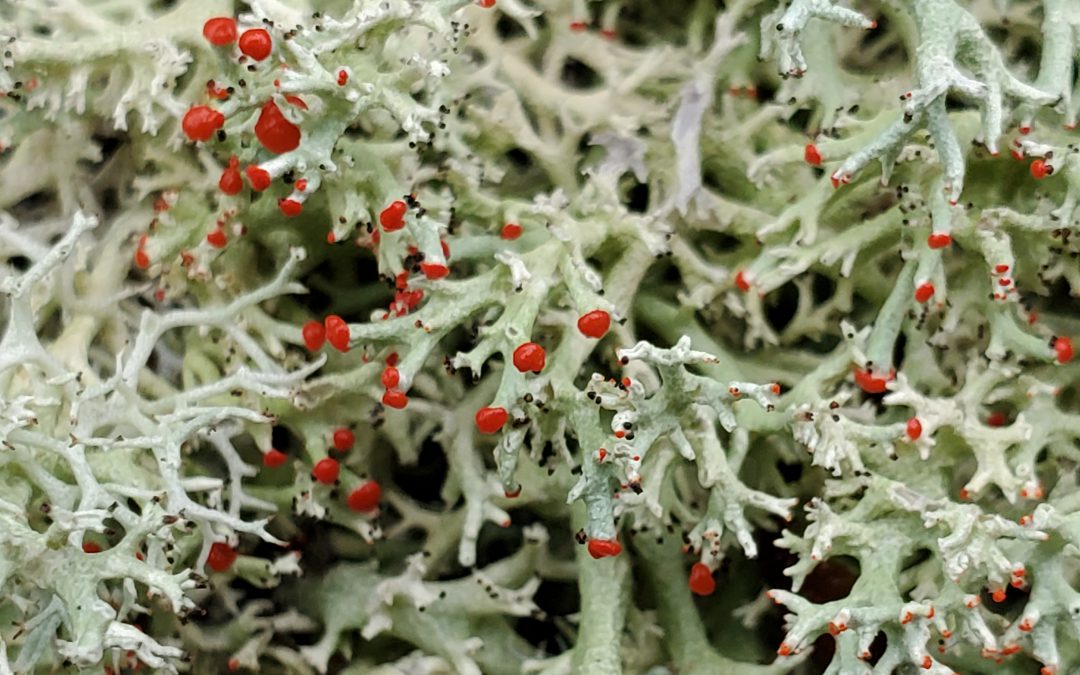
by Evan Anderson | Feb 27, 2020
This time of year, owners of woody plants might notice that leaf canopies are thin. Fruit and ornamental trees, shrubs, and bushes might have shed some leaves over the winter or thinned out due to disease, cold damage, or other problems. When this happens, it can call more attention to the stems of these plants, which may sport a fuzzy, frilly growth on them. More than once I’ve heard people ask, “What is this growing on my plant and how do I stop it from killing it?”.

Red Tipped Lichen – Image Credit Evan Anderson UF / IFAS Extension
Lichen is the fuzzy growth in question, and the good news is that it doesn’t harm the plant it grows on. Lichen is an organism that’s a combination of fungus and either algae or cyanobacteria. The algae photosynthesizes and produces energy to share with the fungus, which provides protection and support. Thankfully, they’re pretty self-contained, and don’t need to steal nutrients or water from whatever they’re growing on. That means they can grow just about anywhere – on rocks, fence posts, tree bark, or on the ground (if you’ve seen deer moss growing in the woods, that’s a lichen!). Again, they are NOT parasitic and do NOT hurt plants.
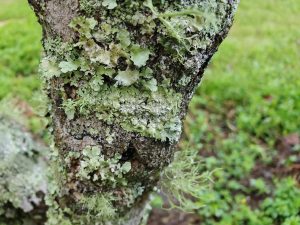
Lichen on Tree Trunk. Image Credit Evan Anderson, UF / IFAS Extension
It’s common to find lichens growing in many different forms and colors. One alarmed tree-owner brought me a branch decorated with a round blotch that had a bright reddish edge. A Christmas Wreath lichen had found a home on her tree, and while the red rings it forms may look alarming, they’re just as innocuous as other lichens. There may be multiple forms of lichen growing in close proximity on a branch, as well. Flat, wavy, rippled, filamentous, bushy, and powdery looking lichen might all mix together to make a strange (or beautiful) looking collection on a tree.

by Larry Williams | Jan 27, 2020
Q. I have a camellia plant that is about 25 years old. It forms flower buds but the buds never fully open. The plant otherwise looks healthy. Is there something that I’m doing or not doing that causes this?

Sasanqua camellia bloom, Photo credit: Larry Williams
A. I have seen this happen over the years. There are a number of possibilities for why this happens. If the camellia cultivar is otherwise known to do well in the area, the problem could be caused by one or more of these factors.
- Stress (primarily drought stress could inhibit buds from opening)
- Freeze damage
- Too many buds on the plant to allow each and every bud to open
However, with this being the norm for your camellia plant for that many years, it may be the wrong camellia variety in the wrong place.
Camellias have been so common in our Southern landscapes that some people think they are native to our area. However, camellias are native to Asia. They were first brought to America during the latter part of the 1700’s.
Years ago, people planted any camellia they could get their hands on because camellias weren’t as common or available and definitely had a more limited selection.
Some camellia cultivars are simply not well adapted to the Gulf Coast and, as a result, will not flower well even though they may grow well here. This is why some varieties are favored in Seattle, some do better in California, some do better in New England and others perform well here in the South.
Even though camellias are a common sight in shady Southern gardens now, not all camellias will perform well here. So, it is important to do some homework before purchasing and planting just any old camellia.
As stated in the UF/IFAS Extension publication Camellias at a Glance, “There are numerous species of Camellia, but the types commonly grown as landscape shrubs in Florida are Camellia japonica, Camellia sasanqua, and hybrids of these.” This publication is available online at https://edis.ifas.ufl.edu/pdffiles/EP/EP00200.pdf or from the UF/IFAS Extension Office in your County.
Sasanqua and japonica camellias come in whites, pinks, reds, double and single flowers and sizes from four to twenty feet tall.
The sasanqua types bloom as early as October while the japonica types begin flowering later.
It is possible to select a few different varieties, instead of just one, to extend the color in your landscape from weeks to months. Selecting camellias for staggered flowering times can provide color all fall and winter long.
When purchasing camellias, research the bloom times of varieties for your area.
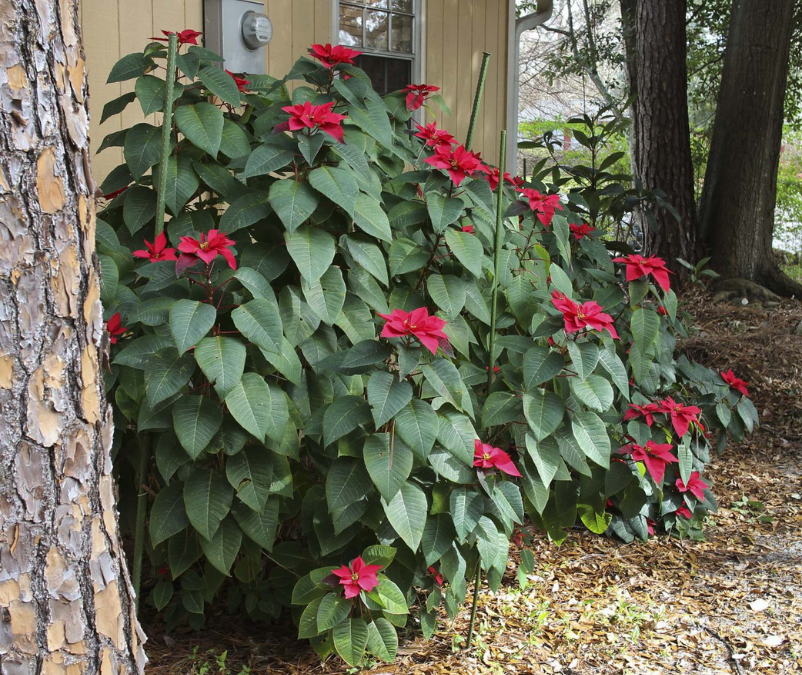
by Ray Bodrey | Jan 22, 2020
Many of us enjoy potted poinsettias during the holiday season. However, we often give up on the poinsettia, once the season is over and the festive color has been lost. With some care, a poinsettia can be around for seasons to come, if planted in your home landscape.

Photo: A mature poinsettia planted outside of a home.
Credit: UF/IFAS, Robert Annis.
Once your poinsettia starts to fade after the holiday, you can prepare it for transplanting. Since we live in the cooler, northern area of the state, you’ll have to hold your plant in a protected area until the danger of frost has pasted. During this period, the poinsettia should be allowed to become dormant. Water it occasionally, just enough to keep it from drying out. A thorough soaking about once a week should be sufficient. Poinsettias are especially sensitive to extremes of heat and cold, as well as sudden temperature changes. Because of this, keep your potted poinsettia away from hot air vents, cold windows and doorways, where temperature fluctuates rapidly. Keep your poinsettia in a brightly lighted area, but never in direct sun.
When you’re ready to plant the poinsettia in your landscape, you should carefully consider its placement relative to the amount of light it will receive. Poinsettias are “short day” plants. This means they will set buds in the fall only if the daily period of light they receive is relatively short. If you plant your poinsettia where it’s exposed to extra illumination from porch, window, or street lights, it may never bloom.
Poinsettias will grow in a wide range of soils, sand, muck, marl, and clay and they will need fertilizer. For the correct nutrients, apply a complete fertilizer, such as a 8-8-8 or 10-10-10, three times a year, beginning when growth starts in the spring, in June, and finally in the late fall, after the bracts (flowering leaves) have set. This last application promotes large bracts with showy color. Apply 1 ½ pounds of 8-8-8 or 10-10-10 per 100 square feet each application of fertilizer.
In late winter or early spring, after blooming is over and the danger of frost is no more, poinsettias should be pruned back to within 12 to 18 inches off the ground. If they’ve been frozen, you may have to cut even lower. To insure compact, showy plants at flowering time, poinsettias should be pruned several times during the growing season. Each time new growth reaches a length of 12 inches, it should be cut or pinched back, leaving four leaves on each shoot. This operation should be continued until about September 10th, but no later. Because poinsettias begin to set buds as days become shorter, pruning after September 10th may reduce flower production.
Following these tips should reward you with another beautiful burst of color next holiday season. For more information contact your local county extension office.
Information for this article was provided by UF/IFAS Extension Horticulturist Dr. Robert Black. More information on the poinsettia can be found at https://gardeningsolutions.ifas.ufl.edu/plants/ornamentals/poinsettia.html
UF/IFAS Extension is an Equal Opportunity Institution.

by Matt Lollar | Oct 8, 2019
Last week at the Panhandle Fruit and Vegetable Conference, Dr. Ali Sarkhosh presented on growing pomegranate in Florida. The pomegranate (Punica granatum) is native to central Asia. The fruit made its way to North America in the 16th century. Given their origin, it makes sense that fruit quality is best in regions with cool winters and hot, dry summers (Mediterranean climate). In the United States, the majority of pomegranates are grown in California. However, the University of Florida, with the help of Dr. Sarkhosh, is conducting research trials to find out which varieties do best in our state.
In the wild, pomegranate plants are dense, bushy shrubs growing between 6-12 feet tall with thorny branches. In the garden, they can be trained as small single trunk trees from 12-20 feet tall or as slightly shorter multi-trunk (3 to 5 trunks) trees. Pomegranate plants have beautiful flowers and can be utilized as ornamentals that also bear fruit. In fact, there are a number of varieties on the market for their aesthetics alone. Pomegranate leaves are glossy, dark green, and small. Blooms range from orange to red (about 2 inches in diameter) with crinkled petals and lots of stamens. The fruit can be yellow, deep red, or any color in between depending on variety. The fruit are round with a diameter from 2 to 5 inches.

Fruit, aril, and juice characteristics of four pomegranate cultivars grown in Florida; fruit harvested in August 2018. a) ‘Vkusnyi’, b) ‘Crab’, c) ‘Mack Glass’, d) ‘Ever Sweet’. Photo Credit: Ali Sarkhosh, University of Florida/IFAS
A common commercial variety, ‘Wonderful’, is widely grown in California but does not perform well in Florida’s hot and humid climate. Cultivars that have performed well in Florida include: ‘Vkusnyi’; ‘Crab’; ‘Mack Glass’; and ‘Ever Sweet’. Pomegranates are adapted to many soil types from sands to clays, however yields are lower on sandy soils and fruit color is poor on clay soils. They produce best on well-drained soils with a pH range from 5.5 to 7.0. The plants should be irrigated every 7 to 10 days if a significant rain event doesn’t occur. Flavor and fruit quality are increased when irrigation is gradually reduced during fruit maturation. Pomegranates are tolerant of some flooding, but sudden changes to irrigation amounts or timing may cause fruit to split.
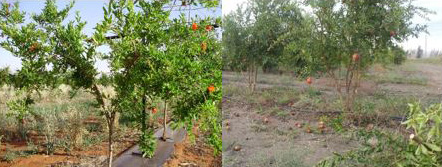
Two pomegranate training systems: single trunk on the left and multi-trunk on the right. Photo Credit: Ali Sarkhosh, University of Florida/IFAS
Pomegranates establish best when planted in late winter or early spring (February – March). If you plan to grow them as a hedge (shrub form), space plants 6 to 9 feet apart to allow for suckers to fill the void between plants. If you plan to plant a single tree or a few trees then space the plants at least 15 feet apart. If a tree form is desired, then suckers will need to be removed frequently. Some fruit will need to be thinned each year to reduce the chances of branches breaking from heavy fruit weight.
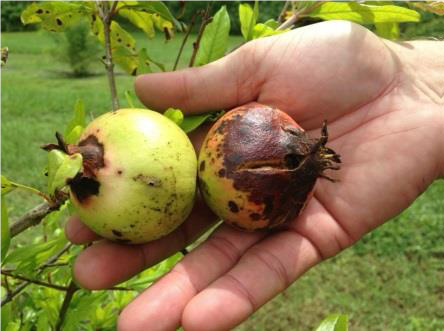
Anthracnose caused by Colletotrichum sp. to pomegranate fruit. Photo Credit: Gary Vallad, University of Florida/IFAS
Anthracnose is the most common disease of pomegranates. Symptoms include small, circular, reddish-brown spots (0.25 inch diameter) on leaves, stems, flowers, and fruit. Copper fungicide applications can greatly reduce disease damage. Common insects include scales and mites. Sulfur dust can be used for mite control and horticultural oil can be used to control scales.

by Matthew Orwat | Sep 17, 2019
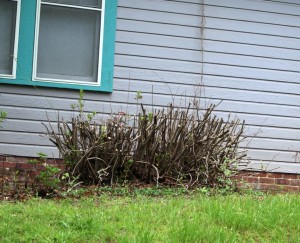
Fall Pruned Azalea. Image Credit Matthew Orwat
Although Northwest Florida is well known for its beautiful Azalea displays every spring, many do not understand that these shows of bloom could be sacrificed completely by pruning at the wrong time.
Pruning Azaleas in the fall will result in a loss of spring bloom the following spring, since flower buds are initialized on previous year’s growth for most azalea cultivars.This means that they flower on growth put on throughout the previous growing season. If a gardener removes the previous season’s new growth, they are removing the blooms as well.
So, when is the proper time to prune Azaleas? The ideal time to prune is directly after the spring bloom. This will give the plant enough time to generate abundant new growth, thus maximizing bloom next spring. One might think that when growing the repeat blooming Encore azaleas, pruning time doesn’t matter. Should the need arise to prune these compact, repeat blooming shrubs the optimal time is directly after spring bloom and not after the final fall bloom cycle.
For more information on pruning Azaleas or on general Azalea culture, please read the UF / IFAS publication Azaleas at a Glance or check out the Pruning Azalea page on Gardening Solutions.

by Beth Bolles | Aug 7, 2019
We are always on the lookout for an attractive plant for our landscape. At the nursery, some plants have a more difficult time gaining our attention. They may not be as showy, possessing neither colorful flowers nor bold foliage. In these cases, we could be missing out on low maintenance plant that offers its own form of beauty in the right landscape spot.
One plant that I love is the Japanese plum yew (Cephalotaxus harringtonia), especially the spreading form ‘Prostrata’. In the nursery container, this plant is nothing special but once established in the landscape it performs well. The conifer type leaves are an attractive dark green and the ‘Prostrata’ selection is low growing to about 2 to 3 feet. An advantage too is that growth is slow so it won’t take over or require routine pruning.
Japanese plum yews grow best in partial shade and once established will be fine with rainfall. For a shadier side of the home, the spreading plum yew has a place as an evergreen foundation plant too.
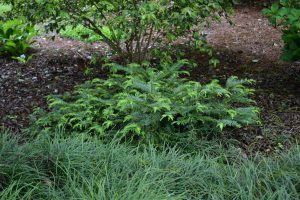
Japanese plum yew in a shaded garden. Photo by Beth Bolles, UF IFAS Extension Escambia County
If the ‘Prostrata’ selection is too low growing for you, consider the ‘Fastigiata’ cultivar that will grow upright to about 8 feet with a 5 foot spread.
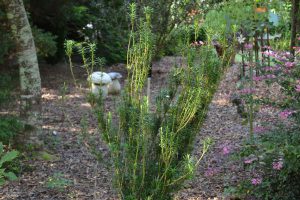
A year old planting of upright Japanese plum yew in filtered light. Photo by Beth Bolles, UF IFAS Extension Escambia County
















